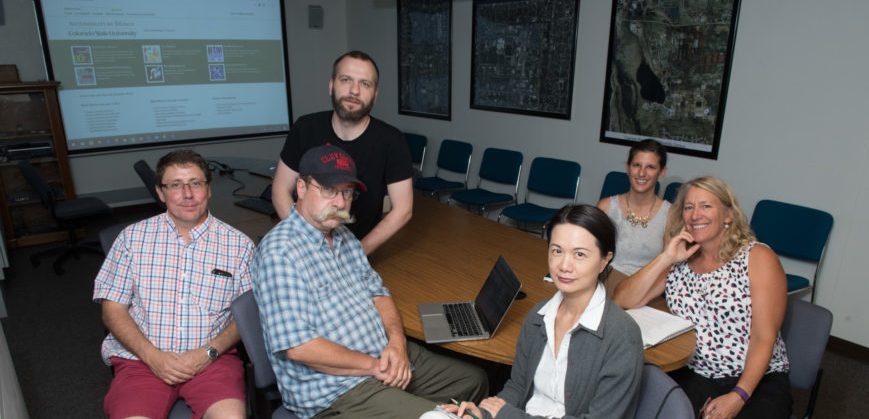
James Cox, Peter Connor, Matt Titchener, Li-Shan Tao, Anna Walker and Marla Roll serve on the
CSU Web Accessibility Subcommittee, dedicated to making online learning materials
usable by all CSU students. Photo by John Eisele, CSU Photography
Colorado State University takes its mission as a land-grant university very seriously. When President Abraham Lincoln signed the Morrill Act in 1862, for the first time in history, higher education became broadly open to people from all walks of life. CSU prizes diversity and the rich history that different populations bring to the academic community, and is proud to provide access to opportunity to anyone with the motivation to earn a degree.
These ideas are also enshrined in The Principles of Community, adopted by the university in 2015, which highlight the importance of inclusion, integrity, respect, service and social justice to all interactions among members of the CSU community.
As part of the concept of inclusion, for the past decade the University has been working to expand access to learning to anyone regardless of physical or other challenges, through implementation of Universal Design in Learning (UDL) principles. UDL strives to eliminate barriers that impact teaching and learning, including for students with visual, hearing or motor impairment, brain injuries, post-traumatic stress disorder, autism, and a wide range of disabilities.
The University adopted the Accessibility of Electronic Information and Technologies Policy in 2004, and updated it in 2016, providing a framework for implementation of UDL principles in classrooms. It is based in part on the work of The ACCESS Project from the Department of Occupational Therapy.
Craig Spooner, ACCESS project coordinator, says the team started its research on how to make UDL effective by collaborating with The Institute for Learning and Teaching and instructors in large “gateway” courses.
Getting the word out
Marla Roll, director of the Assistive Technology Resources Center, has received a CSU Ventures Creative Works Commercialization Award to help faculty and staff learn about the benefits of universally designed instructional materials. Her project, The stories behind universal design, accessibility and diversity: a video curriculum for faculty, will address the growing need to make digital content universally accessible to support the inclusion of diverse students as well as address legal mandates for disability access. Roll and ATRC will create short “storytelling” videos to introduce concepts of diversity and how materials incorporating universal design concepts help all students learn more effectively.
“We helped design good teaching practices that incorporate accessible materials, and the faculty shared with us what they and their students experienced,” Spooner said. “It helped start a cultural shift that works for everyone.”
Assistive technology to overcome barriers
The Assistive Technology Resource Center works to ensure equivalent access to technology and information for all CSU students and employees with disabilities, be they physical or cognitive challenges. ATRC Director Marla Roll was co-investigator on the ACCESS research, and says that while the array of assistive technology that can level the playing field continues to expand, one of her staff’s most important functions is assessment of existing barriers.
“About two-thirds of the students we serve have a ‘non-apparent’ disability; they see themselves as simply having a different way to learn,” she explains. “Much of what they need to learn successfully can happen proactively in the initial design of the course. If faculty anticipate their needs when providing content, with UDL principles in mind, the need for accommodation goes down.”
Embedding Universal Design principles from the start of any project is the key to meeting the needs of the most people within the resources available. A major focus for CSU now is making websites and content accessible, given how much learning is delivered online and in non-traditional formats such as video.
The Web Accessibility Subcommittee is a subcommittee of the campus Web Committee, formed as a direct result of the accessible electronic information and technologies policy. Vice President for Information Technology Patrick Burns has charged the subcommittee with assisting the campus with meeting the demands of the policy.